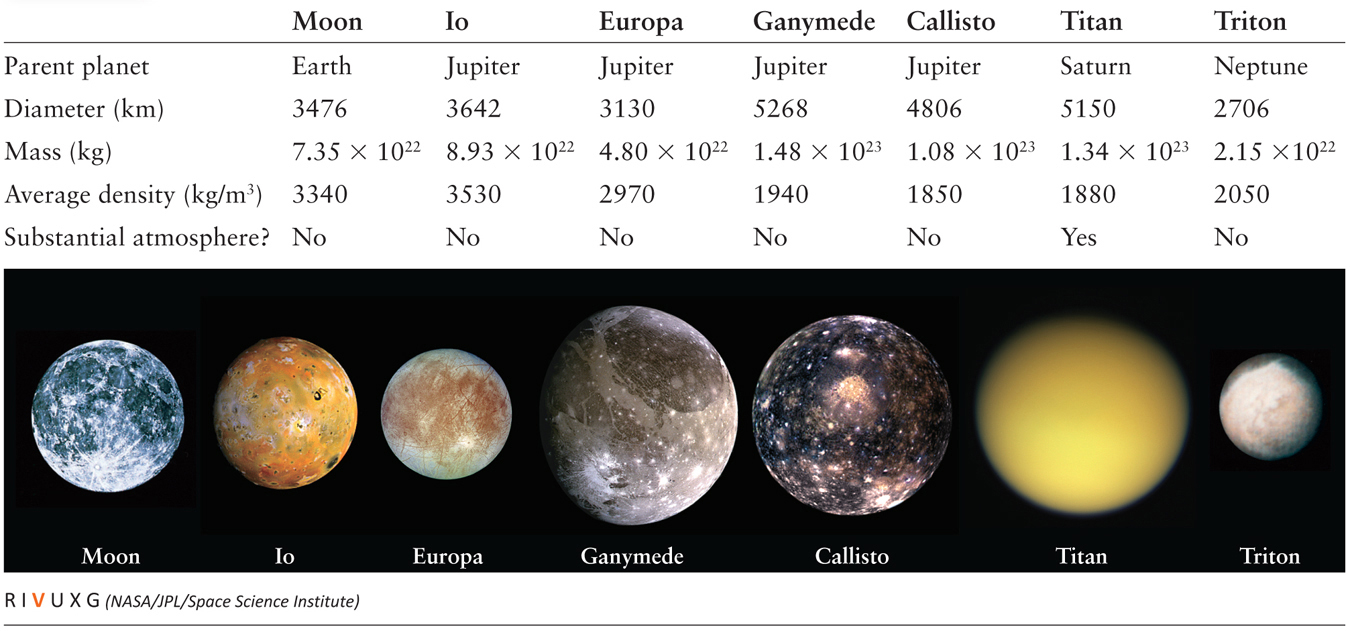4-2 Seven large moons are almost as big as the inner, terrestrial planets
Looking up at Earth’s Moon, you might wonder whether all planets have a brilliant, orbiting object visible in the sky above their surfaces. Astronomers formally call these gravitationally bound, orbiting objects natural satellites, but the more casual names for these objects are moons. All the planets except Mercury and Venus have moons orbiting them. More than 172 moons are known around the eight planets: Earth has one (named Moon), Mars has two tiny ones, Jupiter has at least 67, Saturn at least 62, Uranus at least 27, and Neptune at least 13. Dozens of other small moons probably remain to be discovered as our telescope technology continues to improve. Like the terrestrial planets, all of the moons of the planets have solid surfaces. More than 500 objects in the solar system are formally classified as moons, at least 76 of which are orbiting tiny objects called asteroids and 84 are orbiting trans-Neptunian objects, which we discuss in Section 4-4.
The many unique moons found in our solar system are often as scientifically intriguing as the planets.
You can see that there is a striking difference between the terrestrial planets, with few or no moons, and the Jovian planets, each of which has so many moons that it resembles a solar system in miniature. Of the known moons, seven are roughly as big as the planet Mercury. Table 4-2 lists these moons and shows them to the same scale. Note that Earth’s Moon and Jupiter’s moons Io and Europa have relatively high average densities, indicating that these moons are made primarily of rocky materials. By contrast, the average densities of Ganymede, Callisto, Titan, and Triton are all relatively low. Planetary scientists conclude that the interiors of these four moons also contain substantial amounts of water ice, which is less dense than rock.

92
CAUTION
Water ice may seem like a poor material for building a moon, since the ice you find in your freezer can easily be cracked or crushed. But under high pressure, such as is found in the interior of a large moon, water ice becomes as rigid as rock. (It also becomes denser than the ice found in ice cubes, although not as dense as rock.) Note that water ice is an important constituent for moons in the outer solar system, where the Sun is far away and temperatures are very low. For example, the surface temperature of Titan is a frigid 95 K (−178°C = −288°F).
Interplanetary spacecraft have made many surprising and fascinating discoveries about the moons of the solar system. As one example, we now know that Jupiter’s moon Io has numerous geyserlike volcanoes that continually belch forth sulfur-rich compounds. The fractured surface of Europa, another of Jupiter’s large moons, suggests that a worldwide ocean of liquid water may lie beneath its icy surface. Saturn’s largest moon, Titan, is surrounded by a perpetual haze layer that initially gives it a featureless appearance.
Question
ConceptCheck 4-4: How many moons in the solar system are larger than Earth’s Moon?